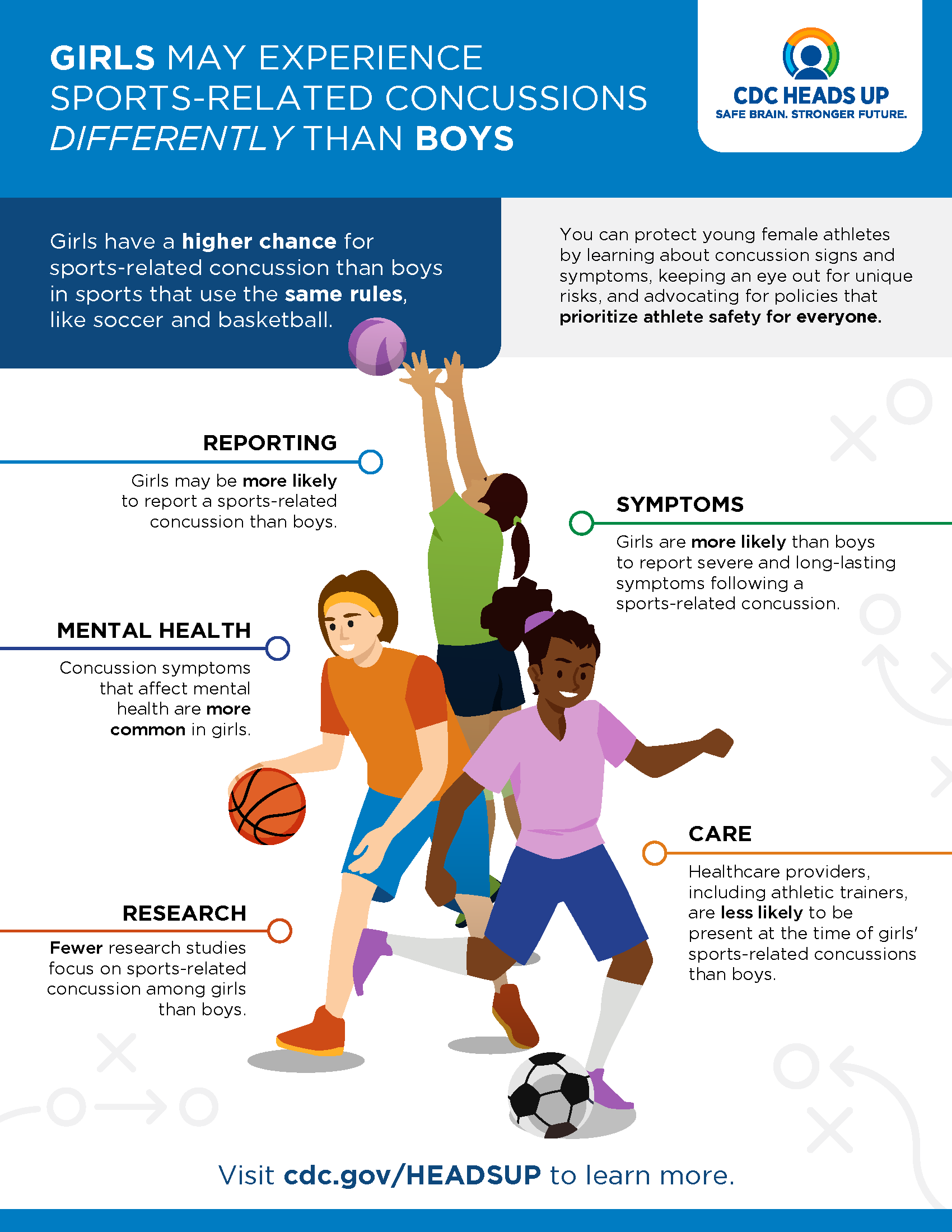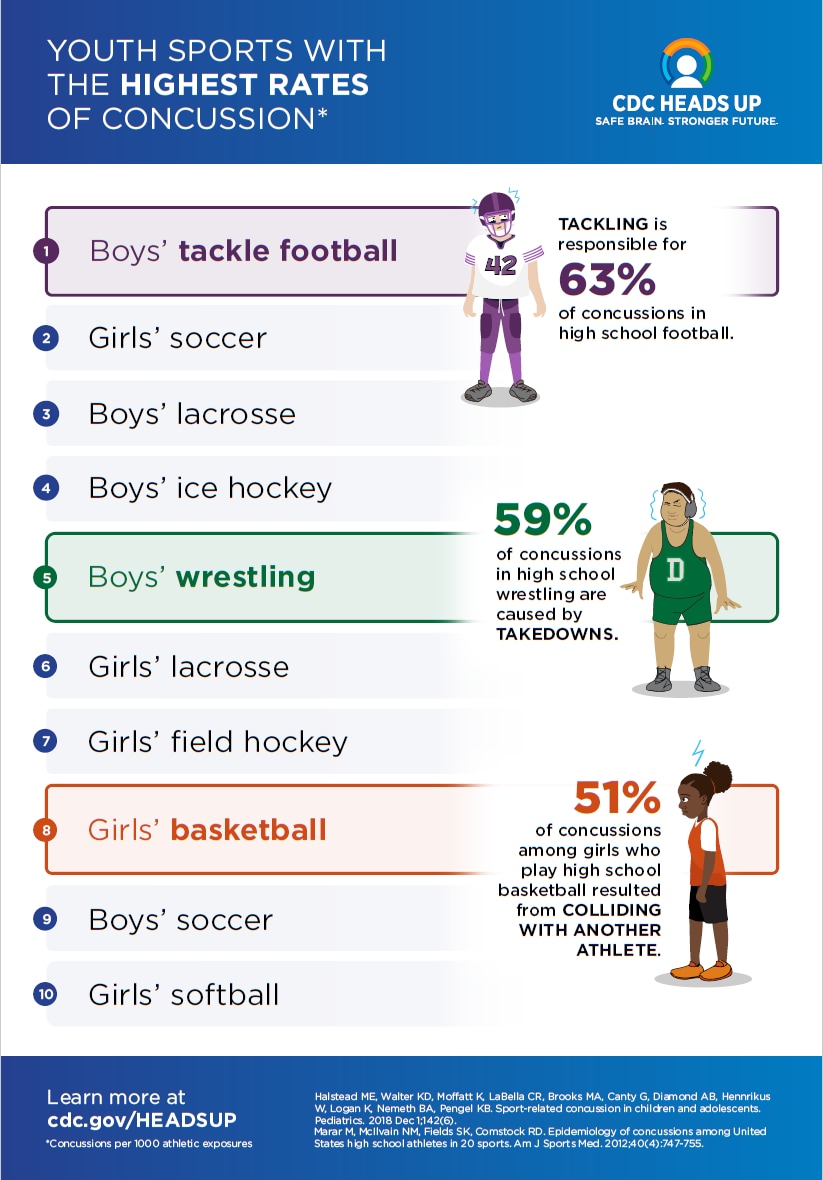Key points

Sports- and recreation-related TBIs and concussions
About 7 out of 10 emergency department visits for sports- and recreation-related TBIs and concussions are among children ages 17 and under.1 For this age group, boys have about twice the rate of emergency department visits for sports- or recreation-related TBIs and concussions than girls.2 However, girls have a higher chance for sports-related concussion than boys in sports that use the same rules, like soccer and basketball.2

Research also shows that:
- Head impacts increase the risk for TBIs and other serious brain injuries.34 The risk for head impacts is highest in contact sports, such as tackle football. Learn more about head impacts in tackle football and how to prevent them.
- Contact sports, including football, basketball, and soccer, are associated with 45% of all emergency department visits for sports- and recreation-related TBIs and concussions among children ages 17 and under.5
- Bicycling and playground activities are also associated with high numbers of emergency department visits for TBIs and concussions among children.2
- TBIs are the leading cause of death and disability among children who experience an all-terrain vehicle (ATV) crash.6 The larger the engine and more powerful the ATV, the greater the chance of a child dying from a TBI or sustaining a severe TBI following an ATV crash.6
Concussion rates by sport

The top ten sports with the highest ratesA of concussion include:78
- Boys tackle football
- Girls soccer
- Boys lacrosse
- Boys ice hockey
- Boys wrestling
- Girls lacrosse
- Girls field hockey
- Girls basketball
- Boys soccer
- Girls softball
Common causes of concussion by sport
- About 6 out of 10 concussions in field hockey happen as a result of athlete colliding with a piece of-equipment such as contact with a stick or ball.8
- Defending and chasing a loose ball are the activities that most commonly lead to a concussion.
- Tackling is responsible for almost 2 out of 3 concussions in high school football.8
- Almost half of concussions in high school football happen during running plays.8
- Linebackers sustain 6 out of 10 of all concussions among high school football defensive athletes.8
- Running backs sustain almost half of concussions among high school football offensive athletes.8
- Concussions are 13 times more likely to happen during competitions versus practices in high school ice hockey.8
- Almost 2 out of 3 concussions in high school ice hockey result from collisions among athletes.8
- About 1 out of 3 concussions in high school ice hockey result from being body checked.8
- Half of concussions in high school ice hockey are among athletes in the wing position.8
- About 3 out of 4 concussions among boys who play high school lacrosse occurred as a result from collisions among athletes.8
- Activities commonly linked to concussions among boys who play high school lacrosse are:8
- Chasing a loose ball
- Body checking
- Nearly half of concussions among boys who play high school lacrosse were among midfielders.8
- Activities commonly linked to concussions among girls who play high school lacrosse are:8
- Defending
- Ball handling/cradling
- Concussions in high school soccer most commonly occur when an athlete is heading the ball.8
- About 1 out of 3 concussions among girls happens during heading.
- About 1 out of 4 concussions among boys happens during heading.
- Concussions sustained while heading the ball most commonly result from collisions among athletes.8
Surveillance and research to support data-driven solutions
CDC conducts research on preventing TBIs and concussions and reducing the chance for disability and other potential effects of these injuries.
- Read research published by CDC.
- Learn more about the National Concussion Surveillance System, a state-of-the-art data collection effort that is underway to learn how many Americans (children and adults) get a TBI or concussion each year and the leading causes of this injury.
- Rates are based on concussions per 1,000 athletic exposures (participation in a game or practice).
- Coronado VG, Haileyesus T, Cheng TA, et al. Trends in Sports- and Recreation-Related Traumatic Brain Injuries Treated in US Emergency Departments: The National Electronic Injury Surveillance System-All Injury Program (NEISS-AIP) 2001-2012. J Head Trauma Rehabil. May-Jun 2015;30(3):185-97. doi:10.1097/HTR.0000000000000156
- Sarmiento K, Thomas KE, Daugherty J, et al. Emergency Department Visits for Sports- and Recreation-Related Traumatic Brain Injuries Among Children - United States, 2010-2016. MMWR. 2019;68(10):237-242. doi:10.15585/mmwr.mm6810a2
- Zuckerman SL, Totten DJ, Rubel KE, Kuhn AW, Yengo-Kahn AM, Solomon GS. Mechanisms of Injury as a Diagnostic Predictor of Sport-Related Concussion Severity in Football, Basketball, and Soccer: Results From a Regional Concussion Registry. Neurosurgery. Aug 2016;63 Suppl 1:102-112. doi:10.1227/neu.0000000000001280
- Kontos AP, Elbin RJ, Fazio-Sumrock VC, et al. Incidence of sports-related concussion among youth football players aged 8-12 years. J Pediatr. Sep 2013;163(3):717-20. doi:10.1016/j.jpeds.2013.04.011
- Waltzman DW, LS; Thomas, KE; Sarmiento, K. Trends in Emergency Department Visits for Contact Sports-Related Traumatic Brain Injuries Among Children — United States, 2001–2018. Morbidity and Mortality Weekly Report. 2020; https://www.cdc.gov/mmwr/volumes/69/wr/mm6927a4.htm
- Jennissen CA, Denning GM, Aitken ME, et al. American Academy of Pediatrics Recommendations for the Prevention of Pediatric ATV-Related Deaths and Injuries. Pediatrics. Oct 1 2022;150(4)doi:10.1542/peds.2022-059279
- Halstead ME, Walter KD, Moffatt K, et al. Sport-Related Concussion in Children and Adolescents. Pediatrics. 2018;142(6)doi:10.1542/peds.2018-3074
- Marar M, McIlvain NM, Fields SK, Comstock RD. Epidemiology of concussions among United States high school athletes in 20 sports. The American journal of sports medicine. 2012;40(4):747-755
- West SW, Shill IJ, Sick S, et al. It Takes Two to Tango: High Rates of Injury and Concussion in Ball Carriers and Tacklers in High School Boys' Rugby. Clinical journal of sport medicine : official journal of the Canadian Academy of Sport Medicine. Jan 12 2023;doi:10.1097/jsm.0000000000001118
